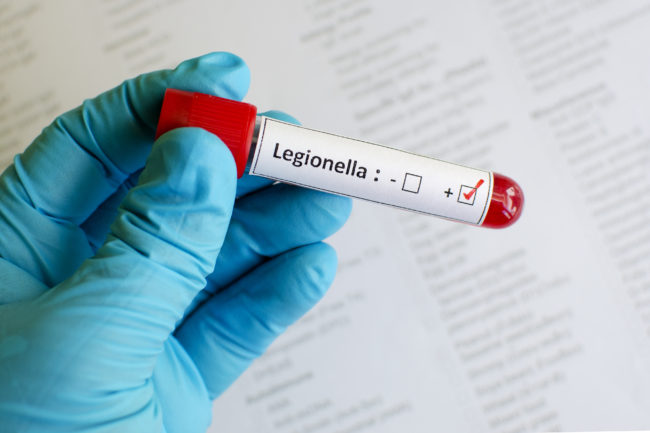The original number of cases of Legionellosis reported by the Centers for Disease Control and Prevention (CDC) for calendar year 2018 was already at a record 8,356 cases. This November, that number was revised upward to 9,933 cases, representing an increase of 18.8 percent . Although Legionellosis includes both Legionnaires’ disease and Pontiac fever, the vast majority of these newly reported cases were for the more serious diagnosis of Legionnaires’ disease.
Legionnaires’ disease is a serious type of pneumonia caused by a waterborne pathogen known as legionella.It is contracted when susceptible individuals inhale water droplets or mist containing elevated levels of thebacteria. Even for those persons exposed to virulent strains of this pathogen, only about 5 percent contract Legionnaires’ disease. Those contracting the disease are susceptible due to age, some pre-existing condition, or a compromised immune system. Smoking, obesity, and diabetes are also risk factors. The death rate from Legionnaires’ disease is approximately 10 percent but approaches 25 percent in susceptible, nosocomial settings. Those who survive the disease may have been comatose, intubated, and may have sustained serious permanent injury such as partial paralysis, brain injury, or amputated extremities following prolonged sepsis and organ failure.
Without question, the number of Legionnaires’ disease cases reported to the CDC has been on the rise since 2000, increasing at a rate of 286 percent for the period of 2000 through 2014. Health departments reported about 6,100 and 7,500 cases of Legionnaires’ disease in the United States in 2016 and 2017, respectively. Clearly, there is consensus that even these numbers do not reflect the full story. The CDC has stated that it believes the actual number approaches 18,000 cases. In August 2019, the National Academies of Sciences, Engineering and Medicine (NASEM) published that it believes the real number approaches 70,000 cases per year in the United States. There appears to be no relief in sight as reported cases in 2019 create national headlines, with outbreaks in Atlanta, Georgia, and Asheville, North Carolina alone, sickening over 210 people. Particularly alarming is data indicating that although outbreaks make news, 95 percent of the reported cases are sporadic and unrelated to an outbreak.
These rising numbers have caught the attention of public health officials in the United States and worldwide, including the World Health Organization, British Health Service Executive, Environmental Protection Agency , Occupational Safety and Health Administration, CDC, and the U.S. Department of Veteran’s Affairs. Private industry associations have also weighed in on the prevention of Legionellosis with specific emphasis in the American Society of Heating, Refrigerating & Air Conditioning Engineers (ASHRAE) 2015 (revised 2018) publication Standard 188. (www.ashrae.org). In June 2017, the CDC published a toolkit for Developing a Water Management Program to Reduce Legionella Growth & Spread in Buildingsstating that “legionella water management programs are now an industry standard for large buildings in the United States,” and citing ASHRAE Standard 188 for this proposition. In 2016, following a large outbreak traced to a cooling tower in the Bronx, both New York City and New York State adopted regulations requiring the registration of all cooling towers, as well as regular testing of cooling tower water specifically for the presence of legionella.
In June 2017 and July 2018, the Centers for Medicare and Medicaid Services (CMS), concerned with the increasing incidence of Legionellosis in nursing home and assisted living facility settings, issued memoranda clarifying its expectations for mitigation of legionella risks. Specifically, CMS explained that its requirement to reduce legionella risks in health care facility water systems included hospitals and long-term care facilities. In August 2019, NASEM released its report on the Management of Legionella in Water Systems, which addressed “the state of the science with regard to legionella.” Historically, appellate courts have exhibited an unwillingness to accept advisory guidelines on legionella management as rising to the level of a standard of care.[i] This appellate review, however, preceded publication of ASHRAEStandard 188, the New York cooling tower regulations, the NAS 2019 publication, and the recent endorsements of the CDC and CMS.
Even when facilities have water management plans in place, Legionella bacteria can still inoculate a water system and amplify. A 2018 investigation conducted by state health officials in Missouri sampled water in a collection of 61 hospitals, nursing homes and hotels over a one-year period. Seven of those facilities tested positive for Legionella despite having active water management plans.
In light of upward trending
numbers of reported cases of Legionellosis and the continuing difficulty in
remediating Legionella from well-managed building water systems, those facilities unable to demonstrate measures to minimize
the risk of Legionnaires’ disease are at risk. Remediation costs following an
outbreak are high. Public health notices, negative media
attention, and building shutdowns expose premises owners to claims for business
interruption. In addition to
potential economic losses, the incidences of litigation arising out of
Legionnaires’ disease outbreaks are increasing. Verdicts and reported
settlements often exceed seven figures. A proactive approach to water
management is imperative.
[i] See, E.g., Vellucci v. Allstate Ins. Co., 431 N.J. Super. 39, 66 A.3d 215 (2013).

